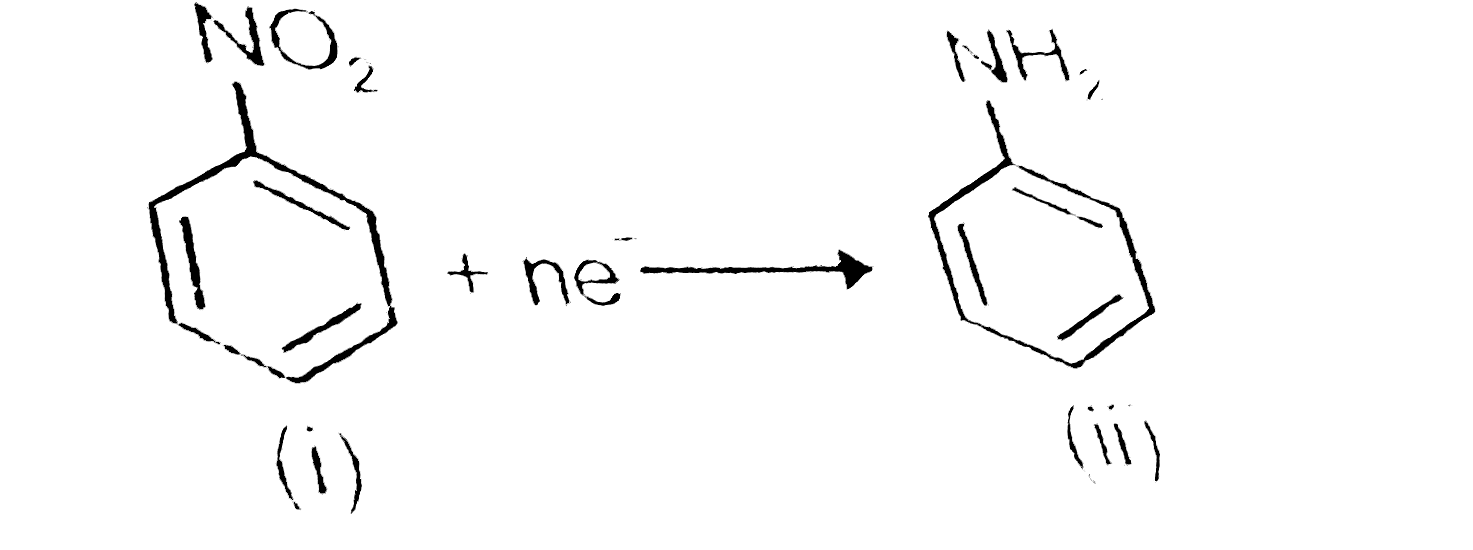Redox is a reaction in which both oxidation and reduction will take place simultaneously . It is obvious that if one substance gives electron there must be another substance to accept these electrons . In some reactions, same substance is reduced as well as oxidised, these reactions are termed as disproportionation reactions.
For calculating equivalent mass in redox reaction change in oxidtaion number is realted to n-factor which is reciprocal of molar ratio.

For converting one mole of nitrobenzene to aniline how many moles of electrons are transferred ?
2
3
6
8
The correct Answer is:C
Step by step video & image solution for Redox is a reaction in which both oxidation and reduction will take place simultaneously . It is obvious that if one substance gives electron there must be another substance to accept these electrons . In some reactions, same substance is reduced as well as oxidised, these reactions are termed as disproportionation reactions. For calculating equivalent mass in redox reaction change in oxidtaion number is realted to n-factor which is reciprocal of molar ratio. For converting one mole of nitrobenzene to aniline how many moles of electrons are transferred ? by Chemistry experts to help you in doubts & scoring excellent marks in Class 12 exams.
Updated on:21/07/2023Topper's Solved these Questions
- REDOX REACTIONSBOOK - AAKASH INSTITUTECHAPTER - REDOX REACTIONSEXERCISE - Assignment (Section E) (Assertion-Reason Type Questions)
8 Videos
- REDOX REACTIONSBOOK - AAKASH INSTITUTECHAPTER - REDOX REACTIONSEXERCISE - Assignment (Section F) (Matrix-Match Type Questions)
5 Videos
- REDOX REACTIONSBOOK - AAKASH INSTITUTECHAPTER - REDOX REACTIONSEXERCISE - Assignment (Section C) (Objective type Questions (More than one option is correct))
18 Videos
- PRINCIPLES OF QUALITATIVE ANALYSISBOOK - AAKASH INSTITUTECHAPTER - PRINCIPLES OF QUALITATIVE ANALYSISEXERCISE - Assignment (SECTION H)
9 Videos
- SOLUTIONSBOOK - AAKASH INSTITUTECHAPTER - SOLUTIONSEXERCISE - ASSIGMENT (SECTION-J) AAKASH CHALLENGERS QUESTIONS
10 Videos
Similar Questions
Knowledge Check
Redox is a reaction in which both oxidation and reduction will take place simultaneously . It is obvious that if one substance gives electron there must be another substance to accept these electrons . In some reactions, same substance is reduced as well as oxidised, these reactions are termed as disproportionation reactions.
For calculating equivalent mass in redox reaction change in oxidtaion number is realted to n-factor which is reciprocal of molar ratio.
Which of the following is an example of redox reaction ?A2NO2→N2O4BNH4OH→NH+4+OH−C2NO2+H2O→HNO3+HNO2DN2O5+H2O→2HNO3Redox is a reaction in which both oxidation and reduction will take place simultaneously . It is obvious that if one substance gives electron there must be another substance to accept these electrons . In some reactions, same substance is reduced as well as oxidised, these reactions are termed as disproportionation reactions.
For calculating equivalent mass in redox reaction change in oxidtaion number is realted to n-factor which is reciprocal of molar ratio.
How many moles of KMnO4 are reacted with one mole of ferrous oxalate in acidic medium ?A25B15C35D53Redox is a reaction in which both oxidation and reduction will take place simultaneously . It is obvious that if one substance gives electron there must be another substance to accept these electrons . In some reactions, same substance is reduced as well as oxidised, these reactions are termed as disproportionation reactions.
For calculating equivalent mass in redox reaction change in oxidtaion number is realted to n-factor which is reciprocal of molar ratio.
This reaction is an example of
Br2+OH−→BrO−3+H2O+Br−AOxidation reaction onlyBReduction reaction onlyCNeutralization reactionDDisproportionation reaction
Redox is a reaction in which both oxidation and reduction will take place simultaneously . It is obvious that if one substance gives electron there must be another substance to accept these electrons . In some reactions, same substance is reduced as well as oxidised, these reactions are termed as disproportionation reactions.
For calculating equivalent mass in redox reaction change in oxidtaion number is realted to n-factor which is reciprocal of molar ratio.
The equivalent weight of Cu2S in the following reaction is
Cu2S+O2→Cu+2+SO3
View SolutionRedox is a reaction in which both oxidation and reduction will take place simultaneously . It is obvious that if one substance gives electron there must be another substance to accept these electrons . In some reactions, same substance is reduced as well as oxidised, these reactions are termed as disproportionation reactions.
For calculating equivalent mass in redox reaction change in oxidtaion number is realted to n-factor which is reciprocal of molar ratio.
When P reacts with NaOH, the products are PH3 and NaH2PO2 which of the following statement is correct ?
View SolutionWhich of the following is the disproportionation redox reaction ?
View SolutionChoose the disproportionation reaction among the following redox reactions.
View SolutionWhich reaction does not represent auto redox or disproportionation ?
View Solution
